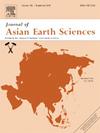Indium distribution in sulfides from a Sn-poor skarn system: A case study of the Lawu Cu–Pb–Zn deposit, Tibet
IF 2.4
3区 地球科学
Q2 GEOSCIENCES, MULTIDISCIPLINARY
引用次数: 0
Abstract
The Lawu Cu–Pb–Zn deposit is situated in the eastern part of Nyainqêntanglha metallogenic belt, Tibet. It represents a rare indium (In)-bearing and tin (Sn)-poor skarn system, however, the occurrence, distribution, and endowment of In, along with their geochemical controls, remain poorly constrained. In this contribution, we conducted a comprehensive mineralogical study of sulfides using microscopic observation, electron probe micro-analyzer (EPMA), and laser ablation inductively coupled plasma mass spectrometer (LA–ICP–MS). Based on mineral assemblage and textural relationships, four types of sphalerite are identified: sphalerite I as micro-inclusions within chalcopyrite and pyrrhotite, sphalerite II with abundant mineral inclusions, sphalerite III exhibiting chalcopyrite disease with watermelon texture, and sphalerite IV displaying a relatively clean texture with minimal inclusions. Sphalerite I is enriched in In, Cu, Cd, and Mn, whereas sphalerite II and sphalerite IV exhibit variable contents of In, Sn, Cu, Mn, Co, Se, and Ag. Trace elements, such as In, commonly occur in sulfides via isomorphic substitution, with minor amounts present as micron-scale mineral inclusions (e.g., Cu in sphalerite; Pb and Bi in sphalerite, chalcopyrite, and pyrite). From the perspective of In content in minerals, In is mainly hosted in sphalerite (average >400 ppm). Chalcopyrite also shows relatively elevated In content (average ∼200 ppm). Pyrrhotite, pyrite, and arsenopyrite typically contain negligible In content, generally below 10 ppm. According to the GGIMFis geothermometer calculations, the crystallization temperatures of sphalerite II to sphalerite IV are as follows: 378 to 427 °C (average = 398 °C) for sphalerite II, 389 to 399 °C (395 °C) for sphalerite III, and 338 to 375 °C (356 °C) for sphalerite IV. The In, Cu, and Co contents in sphalerite increase with crystallization temperatures, implying that their incorporation is primarily controlled by the temperature of ore-forming fluids. Combined with the published sphalerite dataset, a strong correlation is inferred between In and Sn, Cu, or Fe. Notably, Sn-poor Zn-polymetallic skarn systems represent strategic targets for In resource exploration. This finding refines the understanding of In occurrence and enrichment in Sn-poor skarn systems, providing insights applicable to similar geological environments.
贫锡矽卡岩体系硫化物中铟的分布——以西藏劳乌铜铅锌矿为例
劳乌铜铅锌矿床位于西藏Nyainqêntanglha成矿带东部。它是一种稀有的含铟贫锡夕卡岩体系,但铟的赋存、分布、禀赋及其地球化学控制仍不明确。在这篇论文中,我们利用显微观察、电子探针微分析仪(EPMA)和激光烧蚀电感耦合等离子体质谱仪(LA-ICP-MS)对硫化物进行了全面的矿物学研究。根据矿物组合和结构关系,鉴定出4种类型的闪锌矿:闪锌矿I为黄铜矿和磁黄铁矿中的微包裹体,闪锌矿II为丰富的矿物包裹体,闪锌矿III为黄铜矿病,具有西瓜质地,闪锌矿IV为相对清洁,包裹体较少。闪锌矿I富集in、Cu、Cd和Mn,闪锌矿II和闪锌矿IV富集in、Sn、Cu、Mn、Co、Se和Ag。微量元素,如铟,通常通过同构取代出现在硫化物中,少量以微米级矿物包裹体的形式存在(例如,闪锌矿中的铜;闪锌矿、黄铜矿和黄铁矿中的铅和铋)。从矿物中In的含量来看,In主要赋存于闪锌矿中(平均400 ppm)。黄铜矿也显示相对较高的In含量(平均~ 200ppm)。磁黄铁矿、黄铁矿和毒砂通常含有可忽略不计的In含量,通常低于10ppm。根据GGIMFis的地温计计算,闪锌矿II至IV的结晶温度为:闪锌矿II的结晶温度为378 ~ 427℃(平均398℃),闪锌矿III的结晶温度为389 ~ 399℃(平均395℃),闪锌矿IV的结晶温度为338 ~ 375℃(平均356℃)。闪锌矿中的In、Cu、Co含量随结晶温度的升高而升高,表明它们的结合主要受成矿流体温度的控制。结合已发表的闪锌矿数据,推断出In与Sn、Cu或Fe之间存在很强的相关性。贫锡锌多金属矽卡岩体系是今后稀土资源勘探的战略目标。这一发现完善了对贫锡矽卡岩系统中In赋存和富集的认识,为类似地质环境提供了适用的见解。
本文章由计算机程序翻译,如有差异,请以英文原文为准。
求助全文
约1分钟内获得全文
求助全文
来源期刊

Journal of Asian Earth Sciences
地学-地球科学综合
CiteScore
5.90
自引率
10.00%
发文量
324
审稿时长
71 days
期刊介绍:
Journal of Asian Earth Sciences has an open access mirror journal Journal of Asian Earth Sciences: X, sharing the same aims and scope, editorial team, submission system and rigorous peer review.
The Journal of Asian Earth Sciences is an international interdisciplinary journal devoted to all aspects of research related to the solid Earth Sciences of Asia. The Journal publishes high quality, peer-reviewed scientific papers on the regional geology, tectonics, geochemistry and geophysics of Asia. It will be devoted primarily to research papers but short communications relating to new developments of broad interest, reviews and book reviews will also be included. Papers must have international appeal and should present work of more than local significance.
The scope includes deep processes of the Asian continent and its adjacent oceans; seismology and earthquakes; orogeny, magmatism, metamorphism and volcanism; growth, deformation and destruction of the Asian crust; crust-mantle interaction; evolution of life (early life, biostratigraphy, biogeography and mass-extinction); fluids, fluxes and reservoirs of mineral and energy resources; surface processes (weathering, erosion, transport and deposition of sediments) and resulting geomorphology; and the response of the Earth to global climate change as viewed within the Asian continent and surrounding oceans.
 求助内容:
求助内容: 应助结果提醒方式:
应助结果提醒方式:


